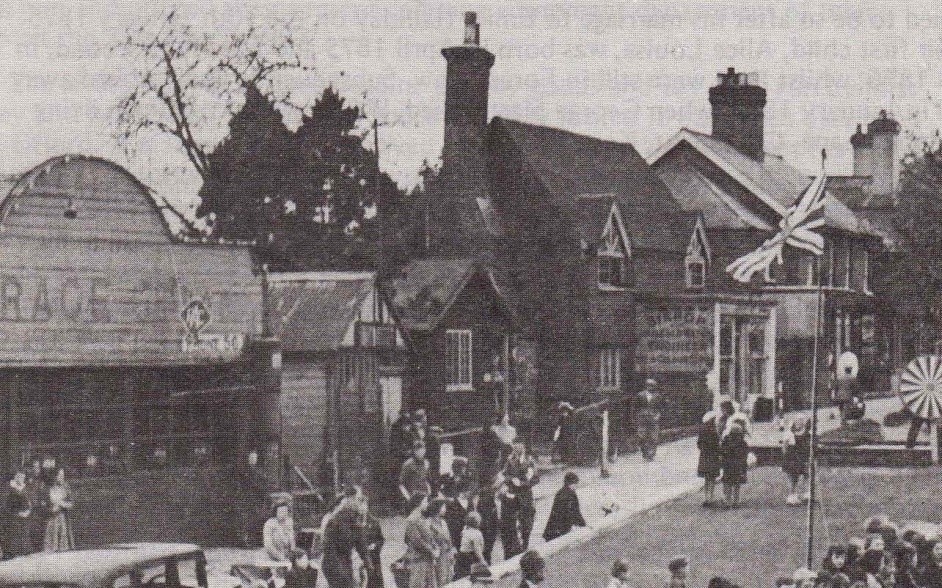WALTER MARTIN
Private, 17882, 12th Royal Sussex Regiment
Killed in Action, Battle of the Somme, France, 17 October 1916, aged 18
Commemorated on the Thiepval Memorial, Pier and Face 7c
Walter Martin, baptised on 31 July 1898 and known to his friends as Wally, was only 18 years old when he died, making him the youngest man to be commemorated on the Forest Row Memorial. He was the son of Alfred and Elizabeth Martin (probably née Baldwin), who seem to have married in Brighton in 1883.

Hillside, Forest Row, before 1960s development. Waghorn's, with a Victorian façade, is on the far right
It is likely that he was born in a house called Waghorn's, which was situated on Hillside, Forest Row, roughly where Lloyds Pharmacy is today. In 1901, when Walter was two, he was living with his father, a brewer's drayman, his mother, and older siblings — Clara, aged 19, a laundry-maid, and Alfred, 17, a plumber. In 1911, minus Clara, the family was enumerated at Castle Cottages in Forest Row. Walter was a scholar and Alfred a plumber, but Alfred senior was now a grocer's assistant. Interestingly, although the marriage is recorded as having lasted 31 years, there is to be no sign of it in 1880, and Elizabeth only owns to having had two children. Whether this was an oversight regarding Clara is not clear.
Walter enlisted at Horsham, and was part of the British Expeditionary Force. In an article written by Richard Caldwell[1] there is a reference to his friend Wally:
My brother James [Thomas James Caldwell] joined up in 1915, when he was little more than 17 years old, and with him was Wally Martin of Castle Cottages Forest Row. They were soon in France and on active service in the trenches. They were waiting to go 'over the top' when a shell exploded above them, instantly destroying Wally and injuring Tom's hand, leg and eye.
Tom, the narrator's elder brother, (referred to as James above), recovered and returned to the front (although he was wounded again) but for Walter, the war was over.
The 12th Royal Sussex Regiment had begun the month of October 1916 at Mailly Maillet, but moved to Auchonvilliers a couple of days later. The war diary for the second week of October shows the battalion alternating artillery activity with relief. The enemy was believed to have few heavy guns opposite the troops in this sector at White City. The entries were still upbeat until 16 October, but on 17 October, the following was recorded. Presumably, young Walter Martin was one of the 156 other ranks referred to:
Enemy made small bombing attack which was easily beaten off in early hours of morning. Day quiet except for intermittent shelling. Another small bombing attack which was repulsed - at 3 p.m. enemy commenced a heavy bombardment of the redoubt with 5.9 28 inch shells which lasted until 8.30 p.m. Our artillery replied vigorously - During the bombardment the Battn was relieved by 14th Hampshire Regiment: Relief complete by 9 p.m. and Battn proceeded to billets at Avellay. Casualties 5 officers 156 O.R.
That said, the Casualty Lists didn't report him as missing until 10 December. Presumably his friend James was in no fit condition to explain what had happened.
When his widowed mother submitted his details for the Forest Row Memorial book, she gave her address as 4, Castle Cottages (the same address is given in the 1911 census). These cottages are described on the National Archives website as being a row of six to the south of Glen View. Glen View still stands on the A22 to the south of the bridge over the River Medway. Castle Cottages, where Walter presumably grew up, would have been between Glen View and the Brambletye Hotel.
Unlike many of the men whose names appear on the Forest Row memorial, Walter came from a family long resident in the area, and was a representative of at least the seventh generation of Martins to have lived in East Grinstead and Forest Row. Walter's great-great uncle Thomas Martin had bought Castle Cottages for £160 in 1847. Deeds describe it as:
A cottage (late stabling) with buildings, yard and land (2r 20p) the northern part of assart land called Dickers ... quit rent 8d and a hen
The property was sold when Thomas died in 1865, so presumably Walter's family were tenants of a later owner. However, his family did own property in Forest Row. Walter's grandfather, George Martin, was a bootmaker, who, according to Forest Row historian Eric Byford, was reputed to be able to make a pair of hobnailed boots in a day, and apparently prospered in the 1860s making boots for railway navvies. In 1873, he bought a property named Waghorn's in Forest Row, and another only identified as the old thatched cottage. These properties, according to Byford, were on what is now Hillside. By this time, his son Alfred, Walter's father, was living with his employer, a baker (Alfred was baker's boy). Following the death of his mother, he moved in with his sister Elizabeth (three years his junior) and they looked after their much younger sister Clara, born in 1875. This is probably why, when Alfred married — to another Elizabeth, around 5 years older than him — he named his first-born child Clara.
In 1881, Alfred's brother (also named Walter) sold Waghorn's and the thatched cottage to Alfred for £260 13s. 4d. Alfred then sold the cottage to his second cousin Henry William Martin, but kept, and continued to live at, Waghorn's until 1901 when he sold it to two more cousins, George Thomas and Bernard Fuller Martin. He and his family then moved to Castle Cottages where he lived until his death in 1917.
Pam Griffiths
8 October 2016
Updated 9 January 2022 & 4 December 2022
1. Source: Richard Caldwell 'Reminiscences of Forest Row, 1900-25, part I', in Eric Byford 'Forest Row, Historical Aspects & Recollections'. [^]

